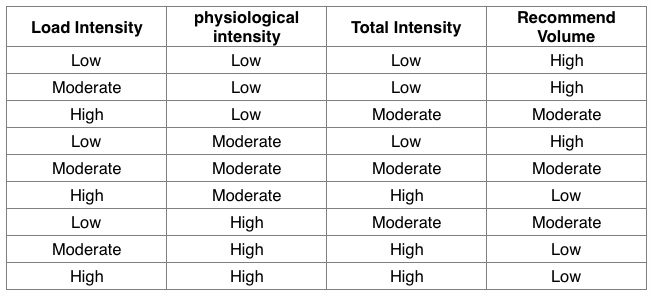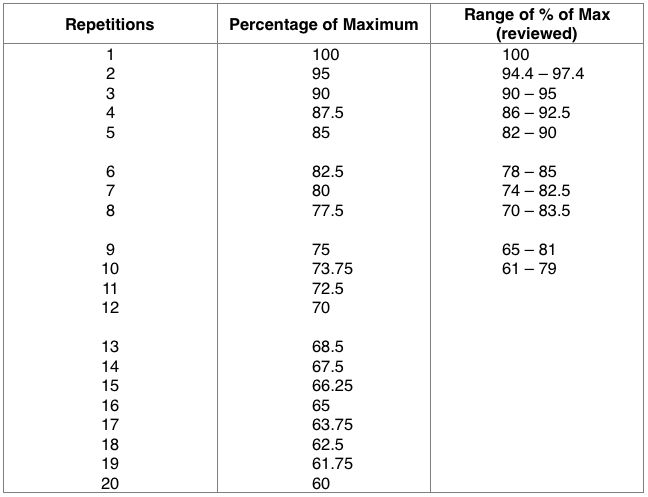There can be two definitions to the term intensity. First refers which is more commonly used and the actual scientific definition is the load intensity or percentage of 1 rep maximum (1RM) – this is the main definition and the one that should primarily be used.
The other definition of intensity refers to the physiological intensity of the training or the level of stress placed on the body from the training whether it is neural or metabolic. This definition maybe used under some circumstances such are during rehabilitation or active recovery.
The load intensity can be high while the physiological intensity remains lower. For example performing 85% RM lift for only singles with a rest period of 4-5 minutes which are usually associated with load of greater than 95% RM. Why would you train in this manner? There could be for a number of reasons one being for the purpose of skills training when leaning a new lift or movement, another could be during an active recovery phase of training.
On the other end of the scale the load intensity can be lower while the physiological intensity is high. For example when perform a 70% RM lift until failure perhaps with minimal rest period between sets as typically done with traditional hypertrophy training.

Intensity Inversely Related to Volume
It must be remembered that Intensity and volume are inversely related and that refers to both load intensity and physiological intensity. The higher the total sum of intensity the lower the volume should be. There are exceptions to this rule as with any rule however it’s always best to side on the side of caution when it comes to overtraining.
If volume is high, intensity is low. To increase intensity you must then reduce volume. The same is true if you reduce the intensity then the volume may be increased. You should avoid programing high intensity with high volume.
Intensity in Multi-Year Periodization
Intensity may have a greater role in a multi-year periodization than volume and should be used to a greater extent than volume. Volume has a limitation for how much volume can be added until it becomes detrimental. Intensity is more constantly progressive and should be utilized prior to relying on volume.
Intensity and Recovery
Intensity is recovery dependent and possibly to a greater extent than volume. As greater intensities in-road in to the recovery ability and adaptive energy of the body this may require longer periods of rest between training sessions. Overtraining may result if intensity and recovery are not closely monitored.
Factors affecting intensity:
– Chronological age
– Training Age
– Gender
– Genetics
– Nutrition
– Psychological Traits
– Acute Training Variables
Chronological Age
Chronological age has a linear relationship with intensity after puberty Generally a younger trainee will tolerate greater individualized intensity than an older trainee. This does not apply to pre-puberty children and teenagers due to a number of factors including formations of joints, ligament and tendon development as well as the differences in biochemistry such as the endocrine system with sex hormones, hGH and IGF-1.
Training Age
Training age may allow greater intensity in training. Ability to recruit high threshold motor units improves with training age allowing greater intensity to be used. The percentage of fast twitch muscle fiber makeup maybe increased (very slightly) with the appropriate training over time.
Gender
Female clients in general do not have the same ability for intensity as their male counterparts. Generally females will be able to perform more repetitions with a set percentage of 1RM than males. Developing intensity for females will be beneficial for all sports but more particularly for strength and power sports.
Genetics
Genetics plays a role in the ability of the individual’s intensity. Identifying specific SNPs can be used to predict the level of intensity an individual will be able to tolerate, recover from and the level of intensity the individual would respond best to for a particular outcome. (More in this in Genetics section).
Nutrition
Psychological traits
The psychological makeup of an individual may influence their potential for training with intensity. This could be both load intensity and physiological intensity. This could be referred to as mental toughness.
Acute Training Variables
Changing the acute training variables can increase intensity. These variables may include repetitions, rep tempo,rest periods, training frequency, training duration, exercise selection, exercise order, training tempo, etc has an effect on intensity.
Methods of Measuring Intensity
As a percentage of Repetition Maximum
Intensity is more commonly measured by comparing the clients level to their maximum effort. The variances that must be taken into account when using this method include that repetitions capable of being performed at a percentage of a 1RM may vary from one client to another. Another factor is that different muscle groups also may be capable of variable repetitions at particular percentage of a 1RM.
As a Reflection of Metabolic Discomfort
Intensity is measured by some as the amount of metabolic fatigue experienced. However neural perception of strength training is the more common and more widely accepted explanation.

As a Percentage of Exertion
This involves combining a specific perception of exertion with a number of reps to determine load or intensity. This is a more acceptable measure to use with a client.
With this in mind, intensity can be viewed multi-level measurement. An example of this may be recorded as below.

This refers to 85% 1RM would normally indicate a repetition bracket of approximately 5 reps however at 85% with a PIL of 6 would indicate maybe only 3 reps is performed with 85% 1RM loading.
Repetitions Short of Technical Failure
This is a less common used, none the less, an effective method of programming intensity. Programming the number of repetitions short of technical failure can be highly effective where technical skill needs to be maintained or maximum strength gains are needed.
Knowing the number of repetitions that would result in technical failure is at best an educated guess based of past training experience.
